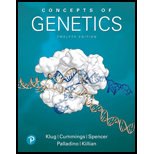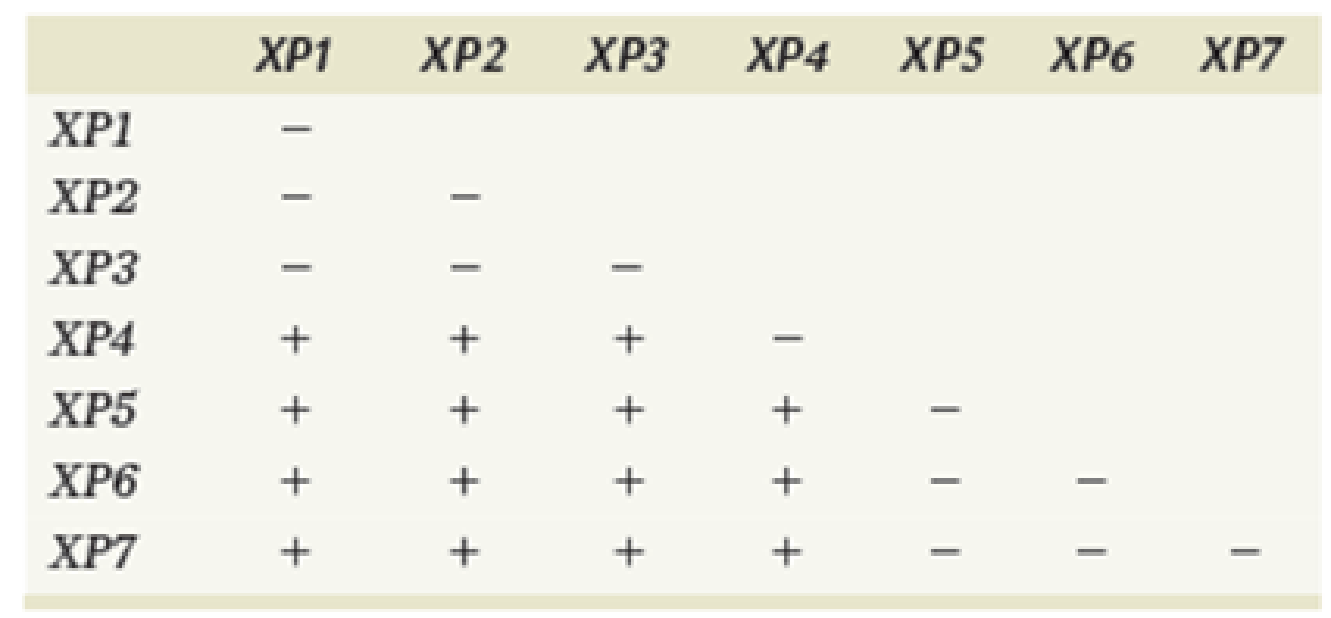
Concepts of Genetics Plus Mastering Genetics with Pearson eText -- Access Card Package (12th Edition) (What's New in Genetics)
12th Edition
ISBN: 9780134811390
Author: William S. Klug, Michael R. Cummings, Charlotte A. Spencer, Michael A. Palladino, Darrell Killian
Publisher: PEARSON
expand_more
expand_more
format_list_bulleted
Concept explainers
Textbook Question
Chapter 15, Problem 24ESP
Presented here are hypothetical findings from studies of hetero-karyons formed from seven human xeroderma pigmentosum cell strains:

Note: + = complementation; − = no complementation
These data are measurements of the occurrence or nonoccurrence of unscheduled DNA synthesis in the fused heterokaryon. None of the strains alone shows any unscheduled DNA synthesis. Which strains fall into the same complementation groups? How many different groups are revealed based on these data? What can we conclude about the genetic basis of XP from these data?
Expert Solution & Answer
Want to see the full answer?
Check out a sample textbook solution
Students have asked these similar questions
Plating 50 microliters of a sample diluted by a factor of 10-6 produced 91 colonies. What was the originalcell density (CFU/ml) in the sample?
Every tutor here has got this wrong, don't copy off them.
Suppose that the population from question #1 (data is in table below) is experiencing inbreeding depression (F=.25) (and no longer experiencing natural selection). Calculate the new expected genotype frequencies (f) in this population
after one round of inbreeding. Please round to 3 decimal places.
Genotype
Adh Adh
Number of Flies
595
Adh Adh
310
Adhs Adhs
95
Total
1000
fladh Adh-
flAdn Adh
fAdhs Adh
Chapter 15 Solutions
Concepts of Genetics Plus Mastering Genetics with Pearson eText -- Access Card Package (12th Edition) (What's New in Genetics)
Ch. 15 - If a point mutation occurs within a human egg cell...Ch. 15 - One of the most famous cases of an X-linked...Ch. 15 - The cancer drug melphalan is an alkylating agent...Ch. 15 - Geneticists often use the alkylating agent...Ch. 15 - Six months pregnant, an expectant mother had a...Ch. 15 - Six months pregnant, an expectant mother had a...Ch. 15 - HOW DO WE KNOW? In this chapter, we focused on how...Ch. 15 - CONCEPT QUESTION Review the Chapter Concepts list...Ch. 15 - What is a spontaneous mutation, and why are...Ch. 15 - Prob. 4PDQ
Ch. 15 - Prob. 5PDQCh. 15 - Why is a random mutation more likely to be...Ch. 15 - Most mutations in a diploid organism are...Ch. 15 - What is the difference between a silent mutation...Ch. 15 - Describe a tautomeric shift and how it may lead to...Ch. 15 - Contrast and compare the mutagenic effects of...Ch. 15 - Why are frameshift mutations likely to be more...Ch. 15 - Why are X rays more potent mutagens than UV...Ch. 15 - DNA damage brought on by a variety of natural and...Ch. 15 - Contrast the various types of DNA repair...Ch. 15 - Mammography is an accurate screening technique for...Ch. 15 - A significant number of mutations in the HBB gene...Ch. 15 - Describe how the Ames test screens for potential...Ch. 15 - Prob. 18PDQCh. 15 - Compare DNA transposons and retrotransposons. What...Ch. 15 - Prob. 20PDQCh. 15 - In maize, a Ds or Ac transposon can alter the...Ch. 15 - Prob. 22PDQCh. 15 - In a bacterial culture in which all cells are...Ch. 15 - Presented here are hypothetical findings from...Ch. 15 - Prob. 25ESPCh. 15 - Prob. 26ESPCh. 15 - What evidence indicates that mutations in human...Ch. 15 - Among Betazoids in the world of Star Trek, the...Ch. 15 - Skin cancer carries a lifetime risk nearly equal...Ch. 15 - It has been noted that most transposons in humans...Ch. 15 - Mutations in the IL2RG gene cause approximately 30...
Knowledge Booster
Learn more about
Need a deep-dive on the concept behind this application? Look no further. Learn more about this topic, biology and related others by exploring similar questions and additional content below.Similar questions
- Which of the following best describes why it is difficult to develop antiviral drugs? Explain why. A. antiviral drugs are very difficult to develop andhave no side effects B. viruses are difficult to target because they usethe host cell’s enzymes and ribosomes tometabolize and replicate C. viruses are too small to be targeted by drugs D. viral infections usually clear up on their ownwith no problemsarrow_forwardThis question has 3 parts (A, B, & C), and is under the subject of Nutrition. Thank you!arrow_forwardThey got this question wrong the 2 previous times I uploaded it here, please make sure it's correvct this time.arrow_forward
- This question has multiple parts (A, B & C), and under the subject of Nutrition. Thank you!arrow_forwardCalculate the CFU/ml of a urine sample if 138 E. coli colonies were counted on a Nutrient Agar Plate when0.5 mls were plated on the NA plate from a 10-9 dilution tube. You must highlight and express your answerin scientific notatioarrow_forwardDon't copy off the other answer if there is anyarrow_forward
arrow_back_ios
SEE MORE QUESTIONS
arrow_forward_ios
Recommended textbooks for you
 Human Heredity: Principles and Issues (MindTap Co...BiologyISBN:9781305251052Author:Michael CummingsPublisher:Cengage Learning
Human Heredity: Principles and Issues (MindTap Co...BiologyISBN:9781305251052Author:Michael CummingsPublisher:Cengage Learning Biology: The Dynamic Science (MindTap Course List)BiologyISBN:9781305389892Author:Peter J. Russell, Paul E. Hertz, Beverly McMillanPublisher:Cengage Learning
Biology: The Dynamic Science (MindTap Course List)BiologyISBN:9781305389892Author:Peter J. Russell, Paul E. Hertz, Beverly McMillanPublisher:Cengage Learning Biology 2eBiologyISBN:9781947172517Author:Matthew Douglas, Jung Choi, Mary Ann ClarkPublisher:OpenStax
Biology 2eBiologyISBN:9781947172517Author:Matthew Douglas, Jung Choi, Mary Ann ClarkPublisher:OpenStax BiochemistryBiochemistryISBN:9781305577206Author:Reginald H. Garrett, Charles M. GrishamPublisher:Cengage Learning
BiochemistryBiochemistryISBN:9781305577206Author:Reginald H. Garrett, Charles M. GrishamPublisher:Cengage Learning

Human Heredity: Principles and Issues (MindTap Co...
Biology
ISBN:9781305251052
Author:Michael Cummings
Publisher:Cengage Learning

Biology: The Dynamic Science (MindTap Course List)
Biology
ISBN:9781305389892
Author:Peter J. Russell, Paul E. Hertz, Beverly McMillan
Publisher:Cengage Learning

Biology 2e
Biology
ISBN:9781947172517
Author:Matthew Douglas, Jung Choi, Mary Ann Clark
Publisher:OpenStax

Biochemistry
Biochemistry
ISBN:9781305577206
Author:Reginald H. Garrett, Charles M. Grisham
Publisher:Cengage Learning


genetic recombination strategies of bacteria CONJUGATION, TRANSDUCTION AND TRANSFORMATION; Author: Scientist Cindy;https://www.youtube.com/watch?v=_Va8FZJEl9A;License: Standard youtube license